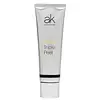What's inside
What's inside
 Key Ingredients
Key Ingredients

 Benefits
Benefits

 Concerns
Concerns

No concerns
 Ingredients Side-by-side
Ingredients Side-by-side

Sodium Bicarbonate
AbrasiveSodium Lauroyl Glutamate
Zea Mays Starch
AbsorbentSodium Cocoyl Isethionate
CleansingCoconut Acid
CleansingCamellia Sinensis Leaf Powder
ExfoliatingWater
Skin ConditioningSodium Isethionate
CleansingPapain
Skin ConditioningZinc Oxide
Cosmetic ColorantLysine Hcl
Skin ConditioningSodium Ascorbyl Phosphate
AntioxidantAcetyl Methionine
Skin ConditioningTheanine
EmollientProline
Skin ConditioningBetaine
HumectantCellulose Gum
Emulsion StabilisingCitric Acid
BufferingCarica Papaya Fruit Extract
Skin ConditioningSorbitol
HumectantGlycerin
HumectantButylene Glycol
Humectant1,2-Hexanediol
Skin ConditioningSodium Hyaluronate
HumectantSodium Bicarbonate, Sodium Lauroyl Glutamate, Zea Mays Starch, Sodium Cocoyl Isethionate, Coconut Acid, Camellia Sinensis Leaf Powder, Water, Sodium Isethionate, Papain, Zinc Oxide, Lysine Hcl, Sodium Ascorbyl Phosphate, Acetyl Methionine, Theanine, Proline, Betaine, Cellulose Gum, Citric Acid, Carica Papaya Fruit Extract, Sorbitol, Glycerin, Butylene Glycol, 1,2-Hexanediol, Sodium Hyaluronate
Water
Skin ConditioningButylene Glycol
HumectantOryza Sativa Powder
Lactobacillus/Punica Granatum Fruit Ferment Extract
Skin ConditioningLactic Acid
BufferingGlycolic Acid
BufferingAmmonium Acryloyldimethyltaurate/Vp Copolymer
Galactoarabinan
Glycerin
HumectantCamellia Sinensis Leaf Extract
AntimicrobialAloe Barbadensis Leaf Juice Powder
Skin ConditioningCaprylyl Glycol
EmollientSalicylic Acid
MaskingCarbomer/Papain Crosspolymer
1,2-Hexanediol
Skin ConditioningLeuconostoc/Radish Root Ferment Filtrate
AntimicrobialDisodium Laureth Sulfosuccinate
CleansingAlgin
MaskingMaltodextrin
AbsorbentLavandula Angustifolia Oil
MaskingLinalool
PerfumingLimonene
PerfumingCitrus Limon Peel Oil
MaskingCitral
PerfumingSodium Gluconate
Skin ConditioningSodium Hydroxide
BufferingPhenoxyethanol
PreservativeSodium Benzoate
MaskingAroma
Water, Butylene Glycol, Oryza Sativa Powder, Lactobacillus/Punica Granatum Fruit Ferment Extract, Lactic Acid, Glycolic Acid, Ammonium Acryloyldimethyltaurate/Vp Copolymer, Galactoarabinan, Glycerin, Camellia Sinensis Leaf Extract, Aloe Barbadensis Leaf Juice Powder, Caprylyl Glycol, Salicylic Acid, Carbomer/Papain Crosspolymer, 1,2-Hexanediol, Leuconostoc/Radish Root Ferment Filtrate, Disodium Laureth Sulfosuccinate, Algin, Maltodextrin, Lavandula Angustifolia Oil, Linalool, Limonene, Citrus Limon Peel Oil, Citral, Sodium Gluconate, Sodium Hydroxide, Phenoxyethanol, Sodium Benzoate, Aroma
 Reviews
Reviews

Ingredients Explained
These ingredients are found in both products.
Ingredients higher up in an ingredient list are typically present in a larger amount.
1,2-Hexanediol is a synthetic liquid and another multi-functional powerhouse.
It is a:
- Humectant, drawing moisture into the skin
- Emollient, helping to soften skin
- Solvent, dispersing and stabilizing formulas
- Preservative booster, enhancing the antimicrobial activity of other preservatives
Butylene Glycol (or BG) is used within cosmetic products for a few different reasons:
Overall, Butylene Glycol is a safe and well-rounded ingredient that works well with other ingredients.
Though this ingredient works well with most skin types, some people with sensitive skin may experience a reaction such as allergic rashes, closed comedones, or itchiness.
Learn more about Butylene GlycolGlycerin is already naturally found in your skin. It helps moisturize and protect your skin.
A study from 2016 found glycerin to be more effective as a humectant than AHAs and hyaluronic acid.
As a humectant, it helps the skin stay hydrated by pulling moisture to your skin. The low molecular weight of glycerin allows it to pull moisture into the deeper layers of your skin.
Hydrated skin improves your skin barrier; Your skin barrier helps protect against irritants and bacteria.
Glycerin has also been found to have antimicrobial and antiviral properties. Due to these properties, glycerin is often used in wound and burn treatments.
In cosmetics, glycerin is usually derived from plants such as soybean or palm. However, it can also be sourced from animals, such as tallow or animal fat.
This ingredient is organic, colorless, odorless, and non-toxic.
Glycerin is the name for this ingredient in American English. British English uses Glycerol/Glycerine.
Learn more about GlycerinWater. It's the most common cosmetic ingredient of all. You'll usually see it at the top of ingredient lists, meaning that it makes up the largest part of the product.
So why is it so popular? Water most often acts as a solvent - this means that it helps dissolve other ingredients into the formulation.
You'll also recognize water as that liquid we all need to stay alive. If you see this, drink a glass of water. Stay hydrated!
Learn more about Water